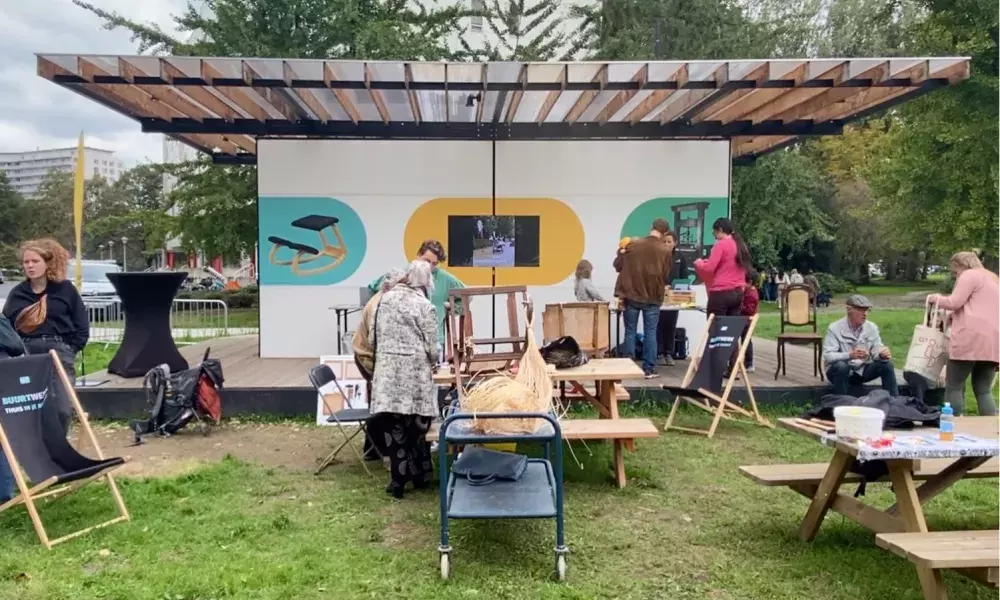
1. EXECUTIVE SUMMARY
The CoGhent project intends to repurpose digitized and digital born cultural data to facilitate the dissemination, reuse, and recombination of institutional cultural heritage data as well as the contribution of the different local communities with stories and artefacts to enrich, complete this city wide repository of cultural heritage data. In creating a multi-voiced platform the project sets out to promote social cohesion within the population of the city through a more open, accessible, rich, diverse and representative digital cultural heritage.
The project is in line with EU ERDF policy objectives focusing on open digital innovation, open access to culture, e-inclusion, community-based cultural services and education as well as similar technological, social, and participatory objectives at national, regional and local levels.
CoGhent designs a data infrastructure focusing on publication and synchronisation of data at its source. This allows for both easier third party and internal reuse of the published data. Internally, the project will co-design The Box, a mobile structure enabling innovative ways to access, and experience cultural data, experiment it in 3 neighbourhoods in Ghent and integrate it as a new dimension of Design Museum Gent.
In the last year since October 2021, the sanitary measures allowed the project partners to catch-up with their project plan schedule, build The Box prototype early spring 2022 and test is in Wondelgem and Watersportbaan, 2 of the 3 neighbourhoods where The Box will travel before being integrated in the new wing of Design museum Gent in 2025. This Journal #2 presents a detailed analysis of the progresses of the CoGhent project through the lens of the 7 challenges defined by UIA highlighting in particular: discussions among project partners about who will take the lead and sustain the different CoGhent building blocks after the project finished; the design of The Box prototype that reveal a lack of participative co-conception with users partly due to COVID lockdowns; the scenarios of interaction of different visitors profiles with The Box prototype into the Design Museum Gent; the early feedbacks and tensions emerging from The Box experimentation process in-progress; the possible emergence of quick and iterative storytelling process along the smooth institutional communication of CoGhent; the outscaling rather than upscaling challenge to bridge between technological, cultural and social arenas.
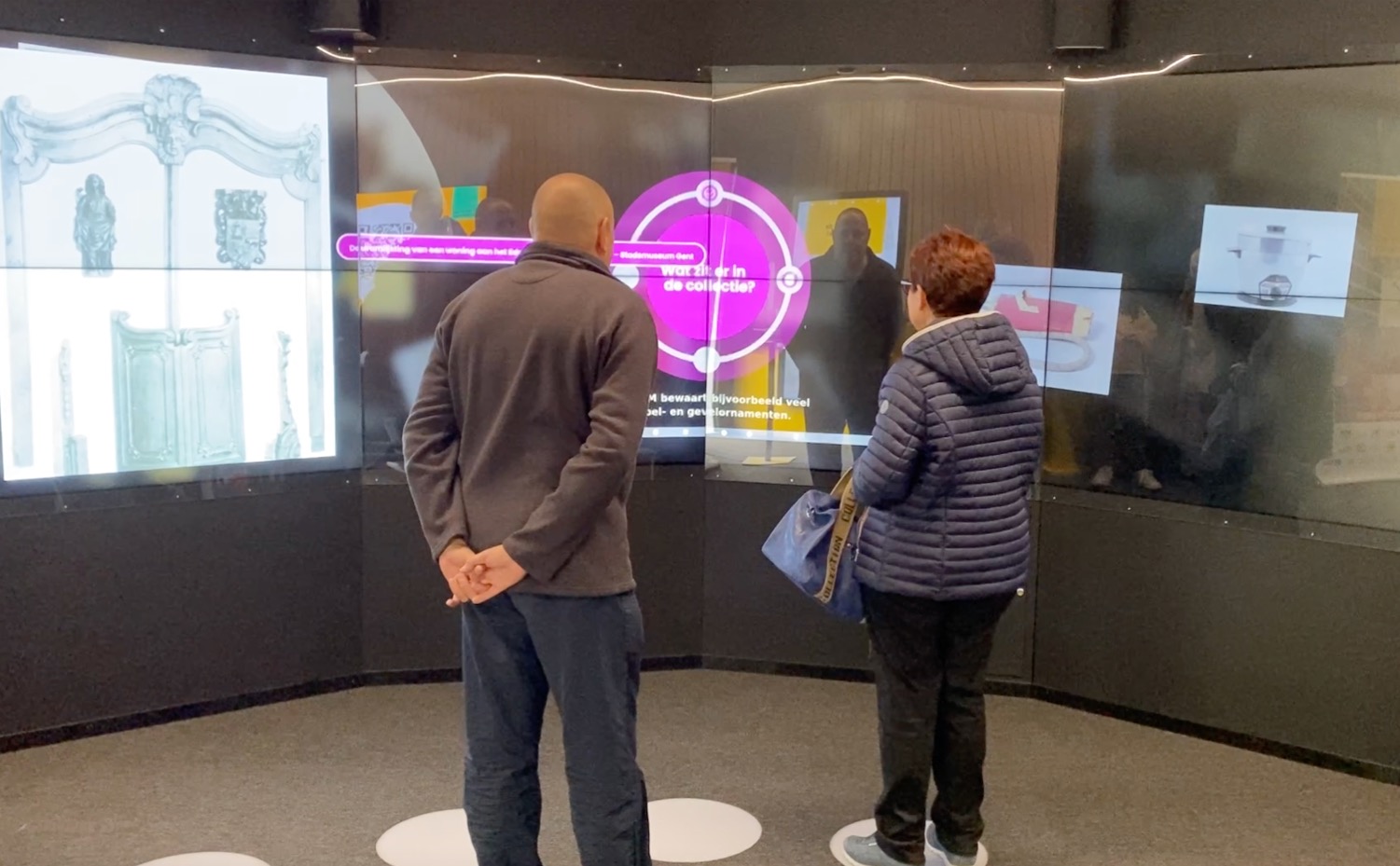
The CoGhent Box multi-screens setting displaying short thematic presentations of digital pictures of heritage with voiceover comment (photo credit François Jégou)
2. STATE OF THE ART
2.1. Introduction to the challenge addressed
More than one core challenge, CoGhent is addressing a series of issues and opportunities concerning cultural heritage, its wholeness, representativeness, accessibility, dissemination through repurposing, etc. in the current trend toward open digital culture.
In particular, the project intends to address 2 streams of issues parallel and interwoven.
On the one hand, citizens have rather few means to contribute to cities’ cultural heritage presented in cultural institutions. In particular, popular history, grassroots’ knowledge, successive flows of migration tend to be missing in territories’ cultural heritage. However, culture has an enormous potential to improve social cohesion. All local communities should find themselves, their actions and life represented and worth to be preserved as common cultural heritage.
On the other hand, digitization of cultural data in progress among museums, libraries, and cities’ cultural institutions struggles to be appropriated and reused by citizens. In particular, lack of common approaches between cultural institutions, of open and accessible platforms slow the potential to reach out to new and larger parts of the population.
Social cohesion and social inclusion through digital culture?
The CoGhent project intends to merge these two streams of issues into an opportunity that draws on the huge potential of digitization to stimulate wide open access to cultural heritage. On the one hand, digitization of cultural data is likely to be an opportunity to unlock cultural capital from the institutional silos where it is currently kept, to make it widely remotely available while stimulating multiple possibilities for its re-use and creative recombination.
On the other hand, the same digitization processes show a great potential to open up, connect and organize the richness and diversity of vernacular culture, testimonies and artefacts coming from the city populations and therefore improve social cohesion and social inclusion.
Bridging between these streams of challenges and opportunities, CoGhent aims at increasing social inclusion and cohesion in the city, supporting the cultural heritage of the city to integrate and evolve towards the opening of cultural digital data.
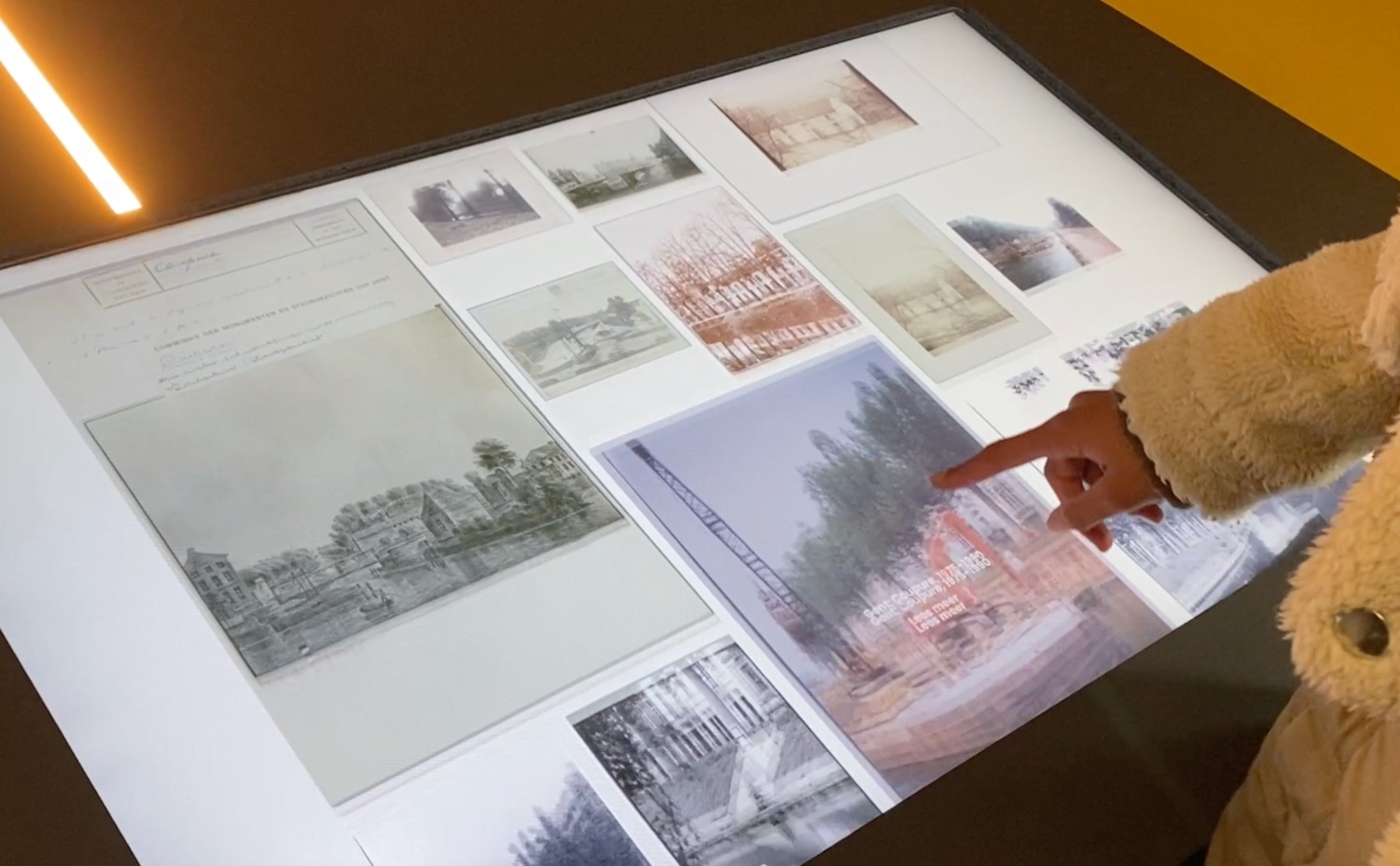
One of the 3 CoGhent Box touchscreens allowing to browse the already 6000 digitized elements of the collections (photo credit François Jégou)
2.2. How does the project fit into the policy context at the EU, national and regional level?
The 2 interwoven streams of digitalisation of cultural data and its repurposing aim of enhancing social inclusion and social cohesion through culture of CoGhent project contributes to 4 of the ERDF thematic objectives:
TO1 Strengthen research, technological development & innovation: CoGhent sets up a city-wide digital architecture to deploy, study, crowdsource, collect, connect and interact with cultural heritage. This open-ended infrastructure will enable sharing, facilitate development, and unlock more innovation.
TO2 Enhance access to, use, and quality of information & communication technologies: CoGhent supports cultural institutions to improve the quality and openness of their collection data. Quality guidelines for digitized heritage will be deployed. This will lead to strengthened applications for e-culture and e-inclusion.
TO9 Promote social inclusion, combat poverty & any discrimination: CoGhent aims to substantially lower barriers to access the urban cultural offer and services, by developing and testing innovative community-based services and community centric methods.
TO10 Invest in education, training & lifelong learning: CoGhent will develop new forms of participatory cultural activities, focused on the accessibility of urban cultural heritage unlocking its values to and within communities (and the tools to collect & connect such heritage). This improves and activates education and lifelong learning.
At national level, the CoGhent project is in line with the National Digital Agenda priorities for Belgium on Digital Government regarding open Data.
At regional level, the project is aligned with Flanders Strategic vision paper on cultural heritage: “[...] update of the immaterial cultural heritage policy with an integrated approach to material and immaterial heritage. More effectiveness and less fragmentation within the (Flemish) cultural heritage sector by working towards more cooperation and coordination. Overall commitment to broad participation and diversity.”
It enriches the smart specialization strategy of Flanders in the field of technological strengths within the spearhead cluster “Creative industries & services” and the 3-helix method with the citizen future-proofing transition in cities.
Finally at local level, the city of Ghent's governance agreement (Oct 2018) sets out priorities for the coming years to particular challenges addressed in CoGhent’s project:
- On Participation: “We improve participation of vulnerable groups, helping them to participate and contribute to leisure and cultural activities. That’s why we focus on an accessible, available, usable and understandable offer”.
- On cultural Heritage: “Material and immaterial heritage from the past gives meaning to the present. That’s why we don't just store and protect it, but also open it and make it publicly available. [...] We want to give more attention and visibility to the heritage of the diverse communities in our cities and will challenge the heritage museums to do so a swell”.
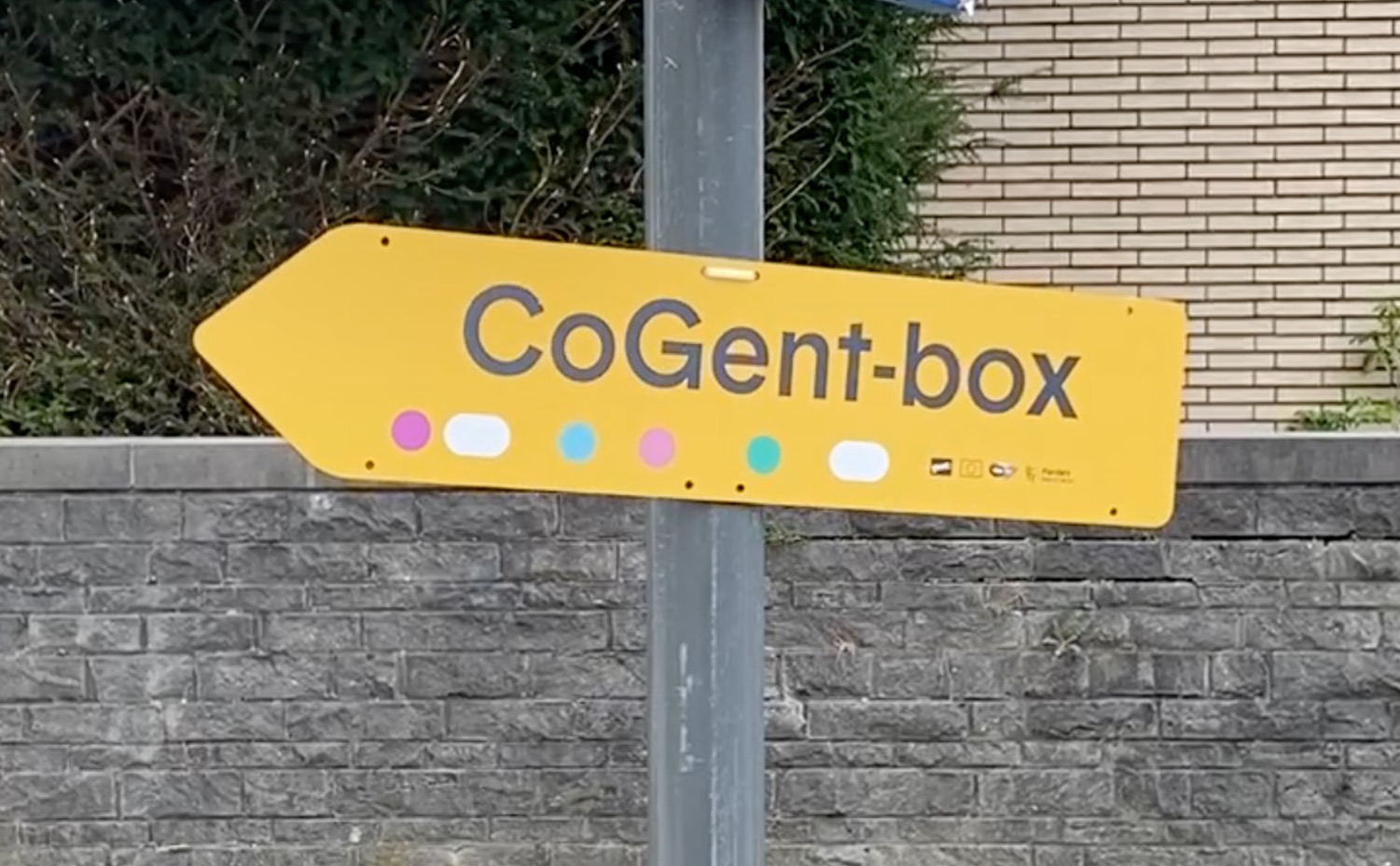
Signs indicating The CoGhent Box location in Watersportbaan (photo credit François Jégou)
3. OPENING CULTURAL DATA FOR CULTURAL INCLUSION
3.1. Introduction to the solution implemented
CoGhent project intends to build the necessary IT infrastructure to enable easier and wider access to institutional culture heritage, facilitate its reuse and recombination on the one hand and on the other hand, enable self-contribution from the population to enrich and complete cultural heritage preserved and disseminated by cultural institutions.
In concrete terms, CoGhent has built an open data platform and a first instantiation of it in a mobile infrastructure called The CoGent Box that will work as the “touch point” and first physical demonstrator of this new digital cultural data city service for all actors of the city and the large public.
The CoGent Box was intended to be the result of a co-design process between the project’s stakeholders and the population of the city. It should allow citizens to both access digitally and enjoy the content currently kept in closed repositories in cultural institutions, capture citizens’ stories and memories to complete and diversify Ghent’s cultural heritage collections.
Plans are to experiment with the mobile CoGent Box and fine-tuned it in 3 pilot neighbourhoods throughout the project and at the end of the 3-year project period, it will be included permanently in the Design Museum Gent.
The CoGhent project intends then to explore and experiment the evolution of cultural institutions of the city and beyond as open and inclusive “cultural third places”, likely to improve the access and participation to cultural and recreational services, foster intercultural dialogue, enable populations from all cultures and backgrounds to find space and to contribute to.
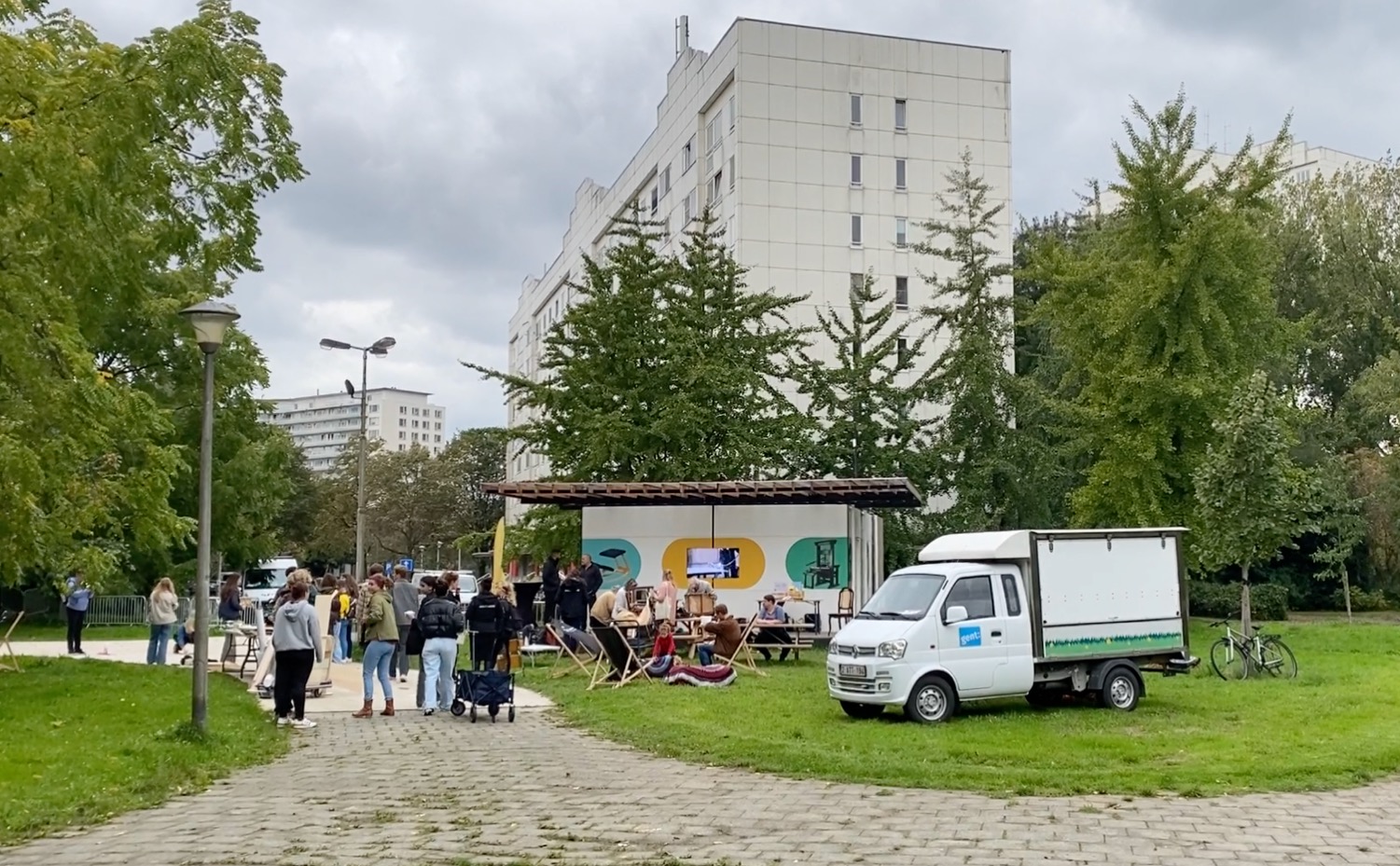
The CoGhent Box installation in the middle of Watersportbaan appartment buldings (photo credit François Jégou)
3.2. Examples of actions
The Box, the prototype issued from the project, is installed successively in Wondelgem, Watersportbaan and Sluizeken-Tolhuis-Ham, 3 neighbourhoods of the city and tested with the populations living there. The second location, Watersportbaan is an unusual neighbourhood, very green, calm and pleasant. Although a lot of people are living in the large apartment buildings, the public spaces seem very empty. The temporary settlement of The Box in a triangle of grass between 3 pathways seems to bring an unusual animation in the area.
A strong engagement process
Around the white pavilion of The Box, armchairs and improvised tables on bales of straw, a small city truck serving drinks and small snacks for the Wednesday “picnic around The Box”. Visits from local schools’ classes are scheduled as well as today a demonstration of the local association of cane chair repairer. The Design Museum is also represented there with a small stock of material and tools to engage visitors in building a wood stool and making the seat by weaving old bicycle chambers. The atmosphere is quite lively with visitors coming in scheduled visits or passing by, sometimes with small groups of 10-15 people and sometimes with as many volunteers and civil servants from the city of Ghent as visitors around The Box.
The experience with digitized collections
Beatrice Truyen, a volunteer from the neighbourhood, leads a visit to The Box for a group of teenagers: “at the entrance a screen lets you choose between 4 stories about chairs, about the circus, about what’s in the Ghent’s collections and a story about Ekkergem neighbourhood nearby. You touch the story that you want to hear and the machine delivers you a QR code ticket. Then you scan your QR code ticket near the screens’ wall. The story starts first with some explanations about how you can interact with the program stepping on colour light dots on the floor and the first section of the story starts by displaying 5-8 selected documents digitized from the so-called “6 collections” from the different city museums and archive. The program zooms on each of the documents while a voice over comments them. You should keep your ticket to access the CoGhent platform later from home”
When the story ends, Beatrice points to the 3 screens on the opposite side of The Box and explains “here you can access all the 62443 objects from the collections already digitized using a large selection of key-words”. The teenagers browse the screens for a short journey into the collections, thanks Beatrice and go out of The Box.
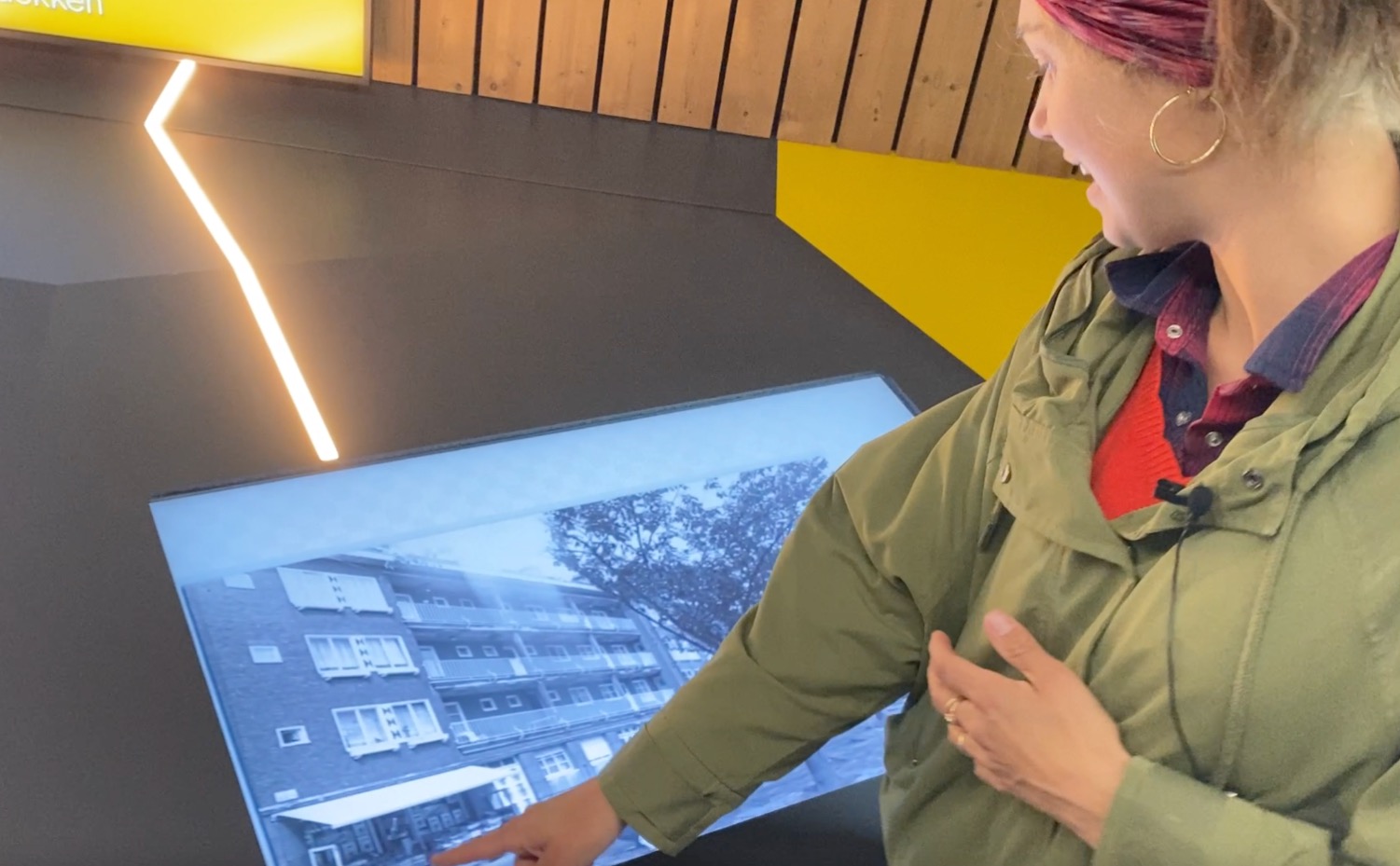
Pictures from the one of the former shop at the ground floor of Watersportbaan appartment buldings (photo credit François Jégou)
A “mini-museum” effect
When asked after the visit what that Box is, most of them agree to say that it’s a “mini-museum” temporarily installed in the neighbourhood. “A new story is being made on Watersportbaan explains Sofie Rottiers, one of the Community workers engaging citizens around The Box. We hope to get this story in The Box before we leave Watersportbaan!” Sien Verschaeren from the Design Museum Gent education team explains why local stories are so important to involve peope: “When they saw old pictures from the time when the neighbourhood was redeveloped, inhabitants were surprised to see that they were shops at the ground floor of most apartment buildings. People are interested in hearing stories touching the place where they live”
For the moment The Box displays interface is very basic and “it’s difficult for people accustomed to very interactive applications on their smartphones, continues Sofie. For instance here they have to listen to one story until it ends before they can start another one”. Mattias, another Community worker following The Box adds “Also, it is not easy to get people inside The Box”. When asked what he would do if he would get a magic stick, Mattias spontaneously answers: “I would have had a mobile Box in a little van settling everyday in another place to involve more people in the neighbourhood but that option was considered as not feasible with the CoGhent budget!”
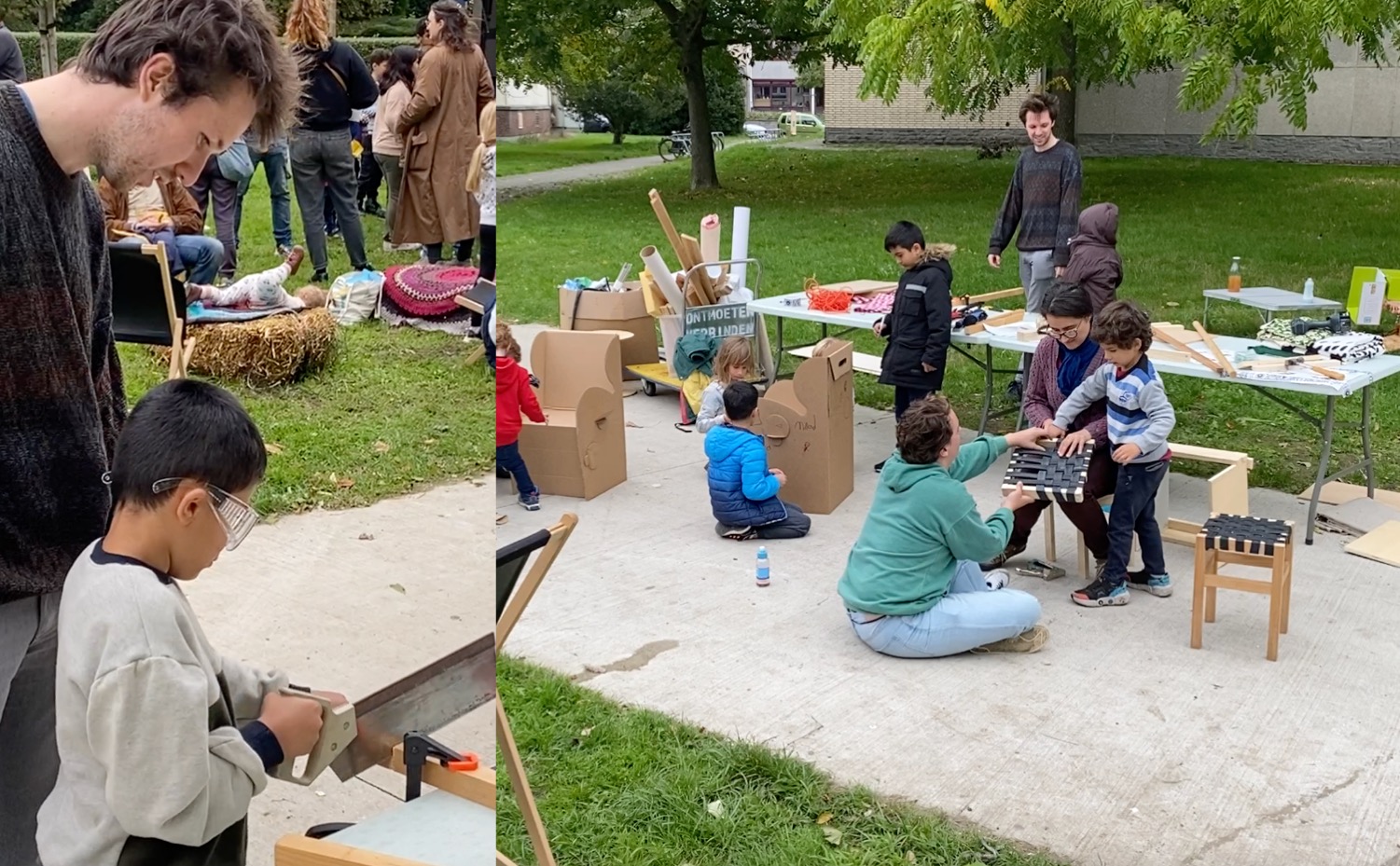
Design Museum stool building activity proposed to engage people around The CoGhent Box (photo credit François Jégou)
4. UIA IMPLEMENTATION CHALLENGES
4.1. General overview
| UIA CHALLENGES | SUMMARY FOR THE COGHENT PROJECT |
| LEADERSHIP | The CoGhent lead team is wondering how to further sustain the project after UIA support finishes. The option of continuing CoGhent as a whole seems not compatible with the current budgetary constraints of the city. The lead team and CoGhent stakeholders are exploring how to further develop the different components of the project, which actor may take the lead on which component, pay for it and ensure its sustainability. |
| PUBLIC PROCUREMENT | Competences for the realisation of the project were already included in the initial partnership of CoGhent and procurement which mostly focused the acquisition of the hardware for the realisation of the Box prototype, runs smoothly through internal IT procurement processes and the facilitation of the CoGhent financial coordinator. No major procurement process took place in the last year outside minor catering or dedicated interventions for events or specific actions |
| ORGANISATIONAL ARRANGEMENTS WITHIN THE URBAN AUTHORITY | The form of open management allows the CoGhent consortium to manage interaction with a large number of stakeholders. This distributed management also revealed to be quite resilient to the Covid crisis. Nevertheless, the successive lockdowns limited consortium interactions and in particular The Box, the resulting instantiation of the CoGhent interaction platform currently tested in different city neighbourhoods seems to lack from a full participative co-design process. The Box launch seems characterized as lots of engagement efforts from Community workers around a “mini-museum”. The hackathon mid-October will provide a new iteration to question and rethink the design of the CoGhent platform and the use of digitized cultural data. |
| PARTICIPATIVE APPROACH FOR CO IMPLEMENTATION | The engagement of the local population in Wondelghem and Watersportbaan neighbourhoods to discover and interact with the prototype of The Box requires a lot of efforts from local volunteers and city community workers. Design museum is also taking part in this engagement process, experimenting with design workshops interacting with its collections and topics. The apparent relative difficulties to raise population interest in the digitized collections into The Box questions also the design of the final integration of The Box hardware and interaction platform into the new wing of the Design Museum Gent: which scenario of use of the mix of official museums’ collections and neighbourhood’s grassroots micro-history ? Which attractiveness for the different profiles of current/potential visitors? Etc.
|
| MONITORING AND EVALUATION | The experimentation of The Box in 3 foreseen neighbourhoods is still half-way and it is still too early to get first consolidated results of the monitoring and evaluation framework in place. A series of interesting tensions are beginning to emerge that need further investigations as for instance between the technological and social goals of the project, between the effort for opening the cultural data and the effort for making the digitized data usable by the city population, between the city cultural institutions’ collections push to different populations of the city and the expected social cohesion through the inclusion of these populations’ cultures into official cultural collection, etc. |
| COMMUNICATION WITH TARGET BENEFICIARIES AND USERS | The institutional communication process of the CoGhent project seems well balanced, frequent both online and offline. Parallel to that professional top-down time and budget consuming process, the very nature of the CoGhent project focusing local communities heritages, contributive process to cultural institutions collections, exploration of interactive new approaches between cultural institutions and local populations calls also for more experimental, quick, rough, direct, iterative memories sharing ands communication processes. |
| UP-SCALING | The overarching upscaling goal of CoGhent is the collaboration between technology and culture and therefore less a matter of bringing the project at a larger scale but rather to integrate many separated bubbles: city Departments, project partners, stakeholders from different cultural, technological and social perspectives to propose original reuse and applications of digitized cultural data, therefore rather outscaling than upscaling. The technological CoGhent platform is based on articulated bricks likely to be recomposed and adapted to other cultural institutions, cities contexts in Europe and beyond as long as these actors are flexible, agile and open enough for this level of innovation and correlated disruption. |
4.2. Detailed analysis
LEADERSHIP
“There is a lot of support, of engagement from all the partners both within the city but also from the commercial and profit partners, explains Pieter-Jan Pauwels one of the 2 ideators with Olivier D’Huynslager of the CoGhent project. Everybody is still very enthusiastic about it but there are also a lot of questions on what will happen after UIA support is finished ?”
Reflections are focussing now on the sustainability of the project. The project is developed and being tested and the CoGhent lead team is looking at how to move forward?
“The project has developed a lot of ingredients, continues Pieter-Jan, and the approach to move forward could be to push it as a whole cake or component per component?”
The first option of considering the CoGhent project as a whole worries stakeholders on budget perspectives. The city is at the moment facing lots of budgetary limitations. After the second round of budget cuts, participants wonder how this financial situation will impact the whole project. There are no doubts on the project value from a strategic perspective but stakeholders seem to have doubts on the operationality to further develop the project as a whole.
The second option of compartmentalization of the projects to move forward component per component seems more accessible but still triggers a lot of questions: who will take the lead on which component? How will the business ownership of each component be managed? The first Journal was discussing the large partnership involved in CoGhent, external partners but also internally the participation of 7 city departments which is at the same time a richness for the project and an issue focusing who is interested to take care of which component, pay for it and make sure it sustains.
The same question arises for operational partners and also for political support. 5 Vice-mayors are supporting CoGhent. Engagement and financial support decisions trigger discussions if CoGhent is rather a cultural project or a technological project or a social project… The transversal and integrated characteristics that constitute a strong value of CoGhent design may be a disadvantage if the initial partnership in time of scarcity of resources, cannot sustain as a whole and the project has to cope with the different administrative silos and different private stakeholders interests.
Next steps about policy ambitions on non-technical aspects in WP4 in november will question the more holistic perspective of the project with actors from the sociocultural and participation side of CoGhent partnership. In January 2023, perspectives for the more technical components of CoGhent will be discussed in particular with the cultural heritage museum and the city archives who first engage on the topic of digitization of cultural data.
Is there then not a risk of a slicing of the project outputs into single components and a loss of CoGhent as a whole articulated project? “Not necessarily, answers Pieter-Jan Pauwels, one of the difficulties of the project we are trying to show now is that for instance we are also doing a slicing of the project on the technological part, but we are trying to show certain component are able to be sustained after the project and certain aren’t and we still have to consider if each part taken individually may be successful without the whole context of CoGhent?”
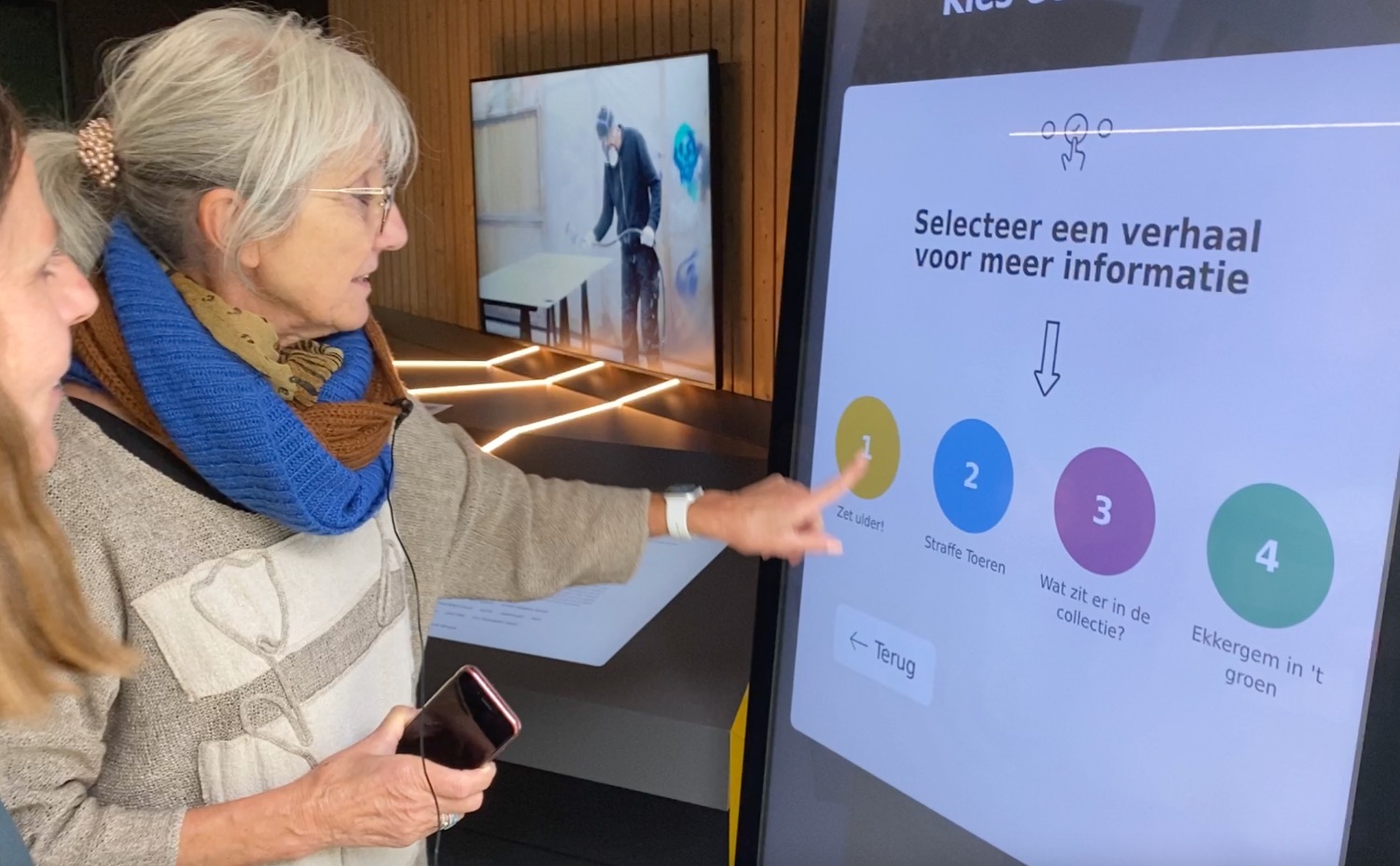
CoGhent Box entrance touchscreen allowing visitors to choose one of the 4 stories available so far (photo credit F. Jégou)
PUBLIC PROCUREMENT
The rich initial setting of the CoGhent partnership already secured all the competencies necessary for the project and most of the procurement issues concerned the acquisition of the hardware material for the construction of the CoGhent Box prototype. This hardware was not seen as strategic aspect to influence local economy or city stakeholders’ ecosystem and was therefore achieved mostly through existing IT procurement canals and frameworks of the city.
This process runs smoothly in particular thank to Jan, the city financial coordinator of the project, stresses Pieter-Jan, that reveals to be very open to help all partners and that has been a very beneficial factor for the project [...] and results also in financial auditing of the project last summer reporting no major issues”
No major procurement process took place in the last year outside minor catering or dedicated interventions for events or specific actions
ORGANISATIONAL ARRANGEMENTS WITHIN THE URBAN AUTHORITY
The large CoGhent consortium, internally 7 departments of the municipality and all the external partners, is collaborating based on a form of open management leaving autonomy and responsibility to each stakeholder. On the one hand, as analysed in the first Journal, this setting requires more time and interaction to start and ensure common understanding and synergy of actions. On the other hand, such a distributed management revealed to be more resilient to crisis such as the successive Covid lockdowns: even with social distanciations and difficult interactions between stakeholders, the relative autonomy of each actors based on the construction of a shared vision, allows development of projects’ components still in a coherent and synergical way.
Nevertheless, the sanitary crisis clashes with the foreseen coconstruction process of the CoGhent project. Despite the strong participation culture of the city of Ghent, the necessary participative approaches that should have brought to the specification of The Box could hardly take place with online only interaction between project partners and very reduced participation of citizens in the neighbourhoods.
The observation of the CoGhent Box settled in Watersportbaan, the second of the three neighbourhoods where it should be tested in Ghent (see Example of action section above), seems to reflect these difficulties. Without pretending to draw conclusions from such a superficial half-a-day field observation, the contrast between the lively interactions attracting the neighbourhood population outside The Box and the relative lower interaction within The Box seems symptomatic of reduced co-construction process due to Covid. If the CoGhent partnership could have conducted a full co-design process starting from such interaction with the citizens as witnessed outside The Box in Watersportbaan, they would probably have arrived at a different setting for The Box.
When asked how the citizens spontaneously named The Box after discovering it in Wondelgem and in Watersportbaan, their answer is clearly “the mini-museum”. If one of the aims of CoGhent was clearly to encourage interaction with cultural institutions beyond usual suspects and with the whole population of the city, this was clearly much more than a mobile sample of the city museums settling outside the city centre where most of the cultural institutions are not.
Interviewed in April 2021, Tomas de Preter from Design Dott design consultancy, main design partner of the CoGhent partnership responsible for the design of the digital platform from user interface to physical installation of The Box was already underlining the ambivalent effects of Covid that “create practical problems on how to design the physical installation but also brought interest of people on the neighborhood where they live and accelerate the adoption of digital interactions”
Beyond Covid clear limitations, the apparent lack of participative design in the design of The Box is all the more surprising as the participative culture of co-design mainly developed in the last decades from the user-centered approach in IT and UX design which is one of the main driver of the CoGhent project. One can wonder if the very fact of naming The Box a “box” was not already a slightly misleading orientation. Even before the adoption of “The Box” as a collective denomination within the CoGhent consortium, its early designation one can still read on the project first outline on UIA website, a “high tech mobile experience room” already contains the idea of a room, which is to say an inside one need to enter in to benefit from the interaction.
“It was quite a waterfall process in the sense that all the cast and design was set-up in the beginning and it left very few margins afterwards to think about improvements, iterations, co-design etc. reflect Pieter-Jan Pauwels, I think we definitely missed that ball. It’s not only a matter of design but we did all that during Covid and it was very hard to think of a design that should improve social cohesion in a time when socialisation was not existent”
But if The Box is the main stage of the prototype process foreseen in CoGhent project plan, it is not the definitive output of the project: it can also be seen as one of the first iteration of its instantiation.
“It’s definitely something that I want to think about, continues Pieter-Jan : how to make sure that the iterative design, the co-design could be more existing in that part of the project. This is also something that we will try to do in the hackathon schedule for the 15th of October 2022: we have the data, we have built The Box and we have built this IT platform but aside from that the question is: if you could do it again what would you make? It’s now only a hackathon practically organized with students but it’s also for us now a way to rethink what else we can do with that cultural data. [...] and in that regard it’s quite successful: we were expecting 50-60 participants but we had to close down the subscriptions because we already have 120 hackers!”
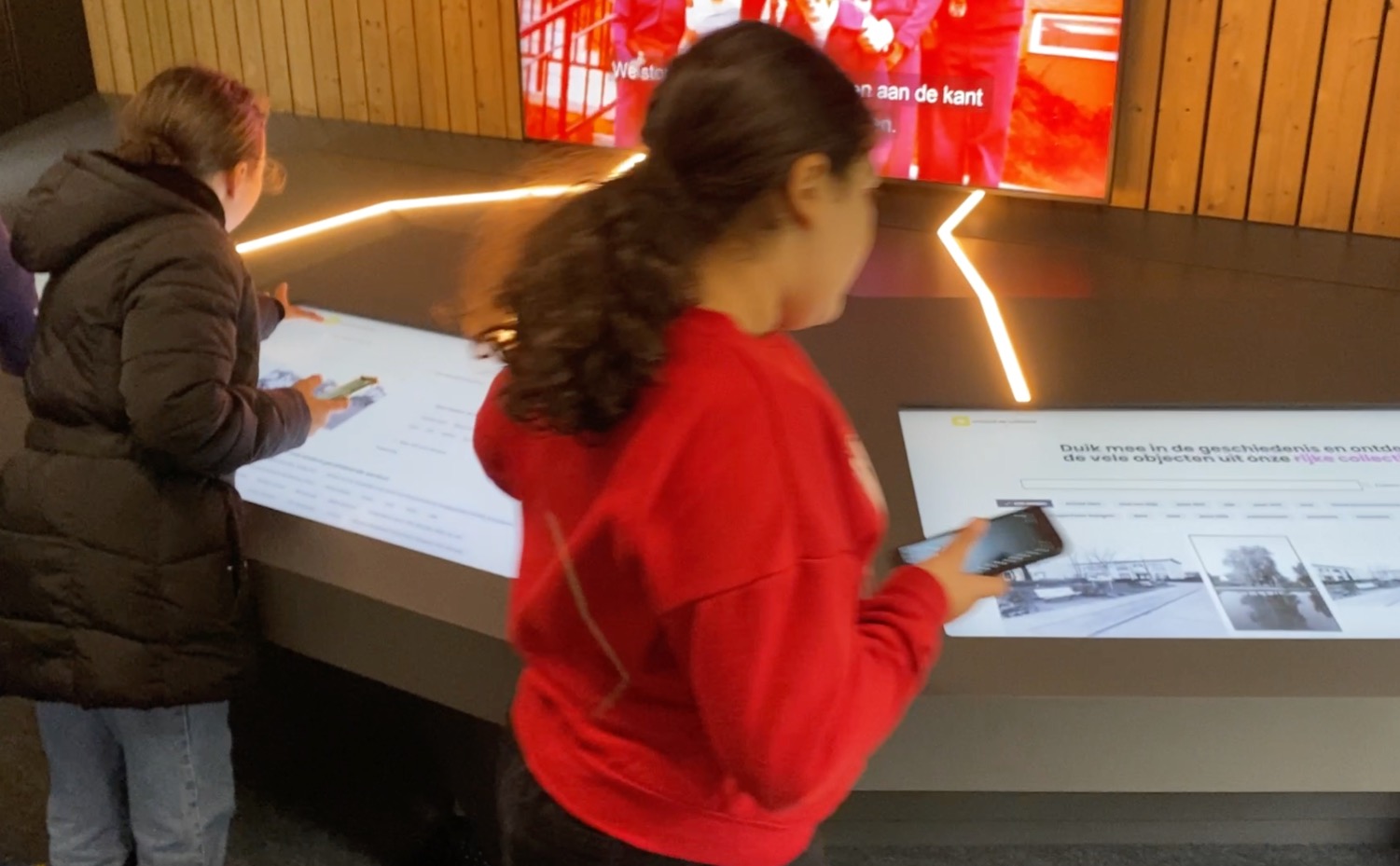
Kids browsing The CoGhent Box screens allowing to access the so far 6000 digitized elements from the 6 collections (photo credit François Jégou)
PARTICIPATIVE APPROACH FOR CO-IMPLEMENTATION
The Box is in its second location of the 3 neighbourhoods it should visit in its testing and experimentation process. As discussed for the previous ORGANISATIONAL ARRANGEMENTS WITHIN THE URBAN AUTHORITY challenge, volunteers and community workers develop a lot of efforts to attract and engage the neighbourhood populations of Watersportbaan in coming to see The Box. They seem to manage to create interaction around The Box, receiving school classes, offering drinks and food, organizing echanges and demos with local NGO’s, etc. resulting in apparently more interaction outside The Box rather than with digitized collections displays inside The Box. This engagement effort, necessary at start is likely to be difficult to sustain in the long run.
“We know that there is a big gap and we want to see how we can bridge that gap, observed Pieter-Jan Pauwels. For instance the Design museum is experimenting for the first time in Watersportbaan how to engage with the local population on design, organizing workshops on furnitures, building chairs with local habitants [...] of course, these activities are the very low-barriers, low-efforts activities for the local citizens. How this will translate into the new wing of the Design Museum is still a question mark. How will we proceed and make sure the technology developed can be used for that as well?”
Then how will The Box setting land into the new wing of the Design Museum? The Box should not be included as a new element of the collections of the museum but rather as a new feature of the institution. The hardware of The Box will be integrated in the new wing of the Design museum in 2025. The exact setting seems still in discussion. So far plans are to move the “screens’ wall” of The Box supporting the display of stories to the museum’s Louis XVI room without any major changes. The other screens of The Box giving access to the browning in the collections should be disseminated in different parts of the Museum in free access for the visitors. How these fit into the story or design narrative of the Design museum Gent has still to be focused. In the CoGhent project plan, this question seems to be part of the Activity 7.5 which is mainly a technological Work Package, therefore not questioning the scenarios of use of both storytelling screen’s wall and collection access screens.
The outer shell of the box was a means to test and validate certain aspects of the project while the new wing of the museum was not available and so far no reuse of that part seems to be foreseen.
From scratch, the initial option of bringing back The Box after its “neighbourhoods tour” appears somewhat contradictory to the project goals: the CoGhent effort of externalization and delocalization from cultural institutions to reach out unusual suspects in the peripheral neighbourhoods seems to clash with the idea of bringing it back in the museum into the city cultural centre. On the one hand, will populations that currently feel far away from cultural institutions, that hardly visit city museums change their habit and visit the Design Museum in the city centre? And on the other hand, will current and new visitors of Ghent’s Design Museum, local “cultural creatives” and around 50 % of tourists interact, listen or contribute to the micro-history of the cities’ neighgourhoods?
These questions could certainly be the occasion to set a proper co-design process that could not take place during the sanitary crisis, involving the different profiles of current/potential visitors of the Design Museum both questioning the content point of view (collection of grassroots stories and objects to enrich museums collections; mix of populations inputs with official collections; combination of bottom-up and top-down editorialisation of these new mixed-collections, etc.) and the scenarios of use for the different profiles (populations not visiting the Design museum, current museums visitors, tourists, professionals, etc.)
MONITORING AND EVALUATION
The experimentation of The Box has started in 2 neighbourhoods Wondelgem and Watersportbaan but it is still very early to get the first consolidated results of the monitoring and evaluation framework in place.
From the technological infrastructure of the CoGhent project, 2 considerations seem to emerge so far.
On the one hand, the very high ambition of the project in terms of opening of the cultural data has been reached and seems even somewhat ahead of professional users potentially able to reuse and recombine the cultural data for other applications. “We now use linked data event stream and linked open data that opens-up a huge amount of sources for participants to an hackathon but also third parties to build upon, stated Pieter-Jan Pauwels [...] we saw in the Co-creation Fund that projects that were submitted were doing very interesting stuff [...] From the API this is already very cutting edge and it makes it very difficult both for internal developers as well as external ones to work with it. This is still something that we are struggling with: it is quite advanced and difficult to make it low barrier”
On the other hand, the usability of the interface provided in The Box, the possibility to make it evolve in quick iterative loops of interactions with users has still a margin for improvement. “If we could visualize the project as a pyramid, continues Pieter-Jan, we have covered the base of that pyramid that is the technological infrastructure, and then the rest of the pyramid which is the technical demonstrator, the web platform, the users interaction with the collections, the cultural lab dimension of The Box has not fully been covered yet. We may have underestimated the infrastructure that was needed to create such a lab”
From the expected social change point of view of the CoGhent project both in terms of access to cultural institutions and their collections and in terms of strengthening of social cohesion in the city, the experimentation is only half-way. The research set-up is based on the theory of change. Only some first workshops have been made with both the cultural institutions as content providers of the collections and the community workers involved with The Box in the 3 neighbourhoods to assess which changes were expected based on the activities the project is doing. Instead of doing the research 3 times in the 3 test neighbourhoods, they will use the first neighbourhood Wondelgem as a way to participatory form the all concept of the theory of change that they want to set-up for this project. They will then use the second neighbourhood where The Box is now in Watersportbaan as a way to assess on a qualitative level whether this instrument really works in that way. And they will use the third neighbourhood Sluizeken-Tolhuis-Ham to both qualitative but also quantitative freely assess whether they have some real impact on the focused changes parameters. Ben Robaeyst in charge with Bas Baccarne both from University of Ghent reports some interesting dimensions emerging in the CoGhent project and to be further investigated: “the balance between technological infrastructure and social cohesion goal? [...] between the 6 cultural partner institutions’ collections that are mostly not situated in the neighbourhoods and these neighbourhoods’ populations interest in very localised history and stories? [...] between the settlement in neighbourhoods as a display of museums digitized cultural data and as a local storytelling collection process? Etc.”
Neslihan Dogan, historian in change of collecting stories in the 3 neighbourhoods where The Box is travelling add to Ben’s list, other dimensions she perceived from her activity point of view for instance: “balance between the short agenda of the CoGhent project and the long time needed for the neighbourhoods’ populations to let their own private intimate stories being displayed publicly? [...] between the 6 cultural institutions involved in pushing collections towards non-users from the city neighbourhoods and the capturing of these same neighbourhoods populations local memories to enrich cultural institutions’ collections? [...] between the act of collecting memories and stories from the neighbourhoods and the moral obligation to give these memories and stories back to these populations in the neighbourhoods? Etc.”
All these emerging tensions aren’t necessarily signs of issues to be solved but first feedback from the CoGhent project to be investigated.
COMMUNICATION WITH TARGET BENEFICIARIES AND USERS
“The communication is quite well balanced, frequent, focused on different channels both online and offline, comments Pieter-Jan Pauwels and this is the Department for Communication of the city that has been doing it. That is certainly a first for European subsidized projects that in such a complexe process as CoGhent, communication is done by the city itself”
For instance the CoGhent productions around the first event based on the former Neptune open-air swimming pool (see 3.2. Examples of first actions in CoGhent’s Journal #1) constitute a very professional pallet of video interviews, well chosen collection of pictures, and a create a form of reviewal of this piece of history of Wondelgem that has been destroyed during the urban development of the city but is still living in the heart of this neighbourhood’s population and of the whole city.
One can wonder if this professional standard is the only form of communication output expected from CoGhent?
“The Communication Department may not have really anticipated that they would have to produce so many videos, continues Pieter-Jan. Videos work very well for people but they imply a lot of overheads coming with filming and editing… They have to balance on how we make sure that we don’t overspend with producing these videos…”
Not only budget-wise the CoGhent communication process should be questioned but also in terms of reactivity: “it’s a very long and heavy process claims Neslihan Dogan, from the collection of stories I am in charge of with the populations of the 3 neighbourhoods, to the selection, editing and recording to deliver finalized stories…”. At the other end of the story production process, Sofie Rottiers, one of the community workers engaging the local population around The Box in the neighbourhoods, regrets that “the period of installation of The Box in Watersportbaan is coming to its end and we still don’t have stories from this neighbourhood to show to the local inhabitants coming to visit The Box!” Guy Dupont, CoGhent interlocutor for the City Archives, one of the cultural institutions partners of the project reflects: “there are Facebook groups with thousands of followers exchanging pictures and memories from local neighbourhoods of the city and CoGhent seems to run in parallel to them…”
These comments would advocate for exploring a more strate-forward and maybe also more rough story editorialization processes in parallel to a more professional institutional communication channel for the project, to build on existing forces focused on city local cultural heritage, to empower them with the technological platform developed by the CoGhent project in order to reach out to unusual suspects… The very nature of the CoGhent project focusing local communities heritages, contributive process to cultural institutions collections, exploration of interactive new approaches between cultural institutions and local populations calls also for more experimental, quick, rough direct, iterative memories sharing and communication processes.
UPSCALING
The question of CoGhent upscaling has been the focus of the first CoGhent Zoom-In “Scaling and scaling out coghent!” presented as a podcast made from the interview of Pieter-Jan Pauwels and Olivier D’Huynslager the 2 ideators of the CoGhent project and discussing how they see the project they imagined and created in the face of this upscaling challenge. Key points of this Zoom-in are:
The overarching upscaling goal of CoGhent is the collaboration between technology and culture that translated in the ambition of the city to become both Capital of Culture and Capital of Technology. CoGhent aiming at social cohesion based on a larger access to culture through digitization and opening of data is emblematic of this ambition and also a testbed for the cooperation of these cultural and technological arenas at all city levels.
The upscaling of CoGhent project reveal to be less a matter of bringing the project at a larger scale but rather to integrate many separated bubbles: 7 city administration Departments accustomed to work in silos, many project partners and stakeholders coming with their different cultural, technological and social perspectives, multiple actors engaged in the CoGhent Cocreation Fund process to propose original reuse and applications ot these digitized cultural data. The CoGhent project approach intends to scale out rather than to scale up. To grow, not by getting bigger as in the industrial model, but by disseminating, or better by inseminating an ecosystem of open projects throughout the city
From the technological point of view, CoGhent will generate a rich “Lego box” odf technological components with a good potential of recomposition and customization of the initial solution to different contexts. For other cultural institutions, other cities interested, the project is not a monolithic platform to adopt or leave but a collection of elements that can be recomposed together to match different local contexts or even used as separated bits.
Possible barriers for CoGhent upscaling or outscaling process are not necessarily technological barriers but rather human barriers: routines in software architectures, lack of culture of participation in the city, lack of flexibility in funding mechanisms in public administration… In particular it refers to the reluctance to open source culture that clashes with the strong sense of ownership in our society: a certain maturity is needed for cultural institutions or for city administrations, to understand that they will gain more from sharing what they have than from keeping ownership.
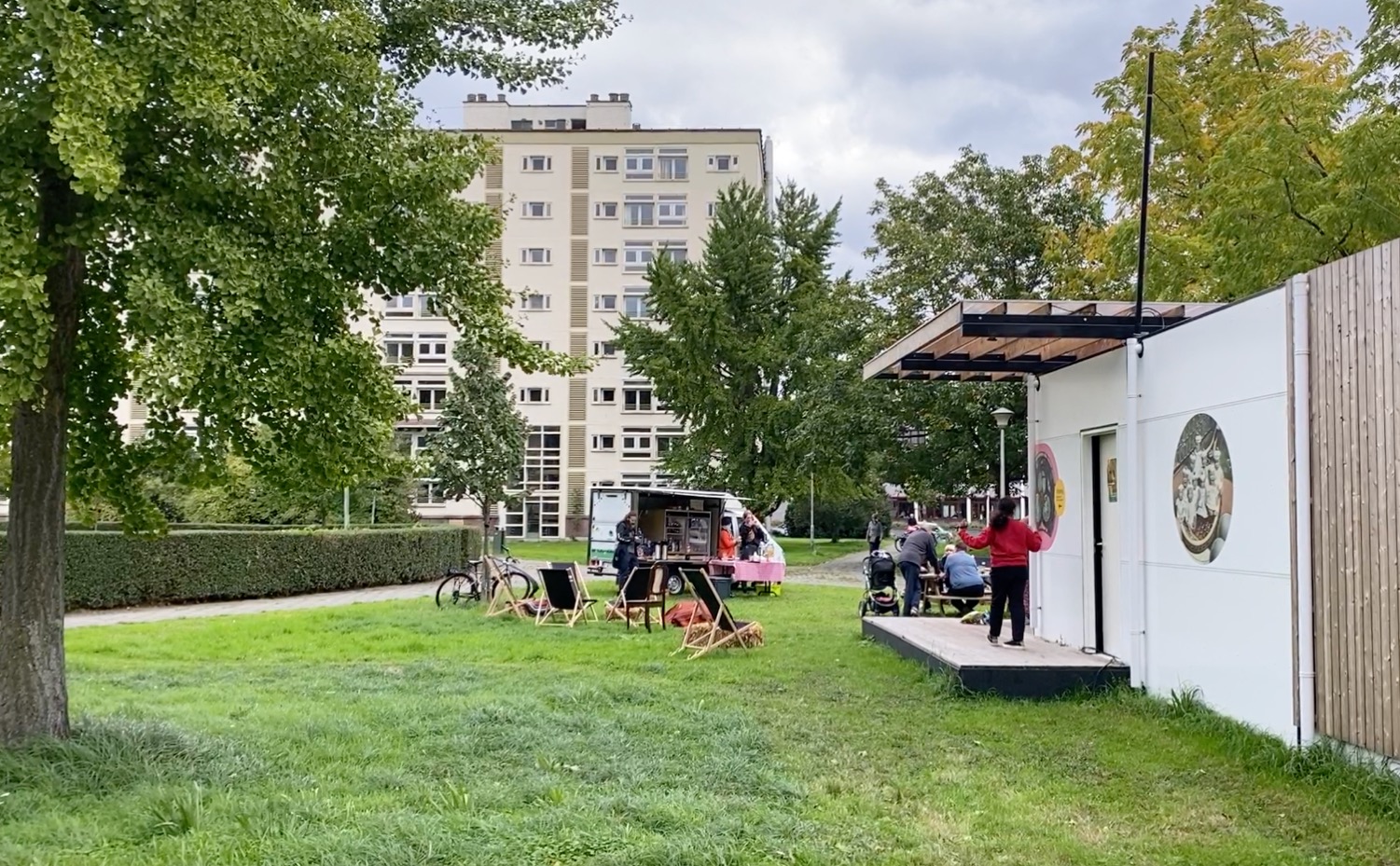
The CoGhent Box installation in the middle of Watersportbaan apartment buildings (photo credit François Jégou)
5. CONCLUSIONS AND NEXT STEPS
The overarching tension the CoGhent project intends to tackle is certainly the challenge to bridge between the technological platform development stream and the city socio-cultural enrichment stream.
Open access to the collections for developers
From the technological side of the project we have a platform made of components which has been built in an iterative way. “It’s not just one big chunk that you cannot change, explains Pieter-Jan Pauwels. It’s very interchangeable. We just got a recognition from the Flemish government of a most sustainable innovation project on that aspect a few weeks ago, for the back-office and how we used the data. It's a very innovative project where the technological components can be reused but it’s something that of course citizens cannot see, it’s a very technical back-office thing…”
Social cohesion through culture sharing in progress
One of the other main interests of Coghent is the expected outcome of the project in terms of socio-cultural cohesion: how digitization of cultural data could improve the social cohesion in the city? Main stakeholders involved on this issue are the city service in charge of the community workers and the public engagement teams within the cultural heritage institutions. “Those are the 2 main forces in the project partnership, adds Carmen van Puyenbroeck, coordinator of the project, that needs to converge into a transversal leadership to ensure a continuity in terms of social cohesion outputs of CoGhent”
The Box as only a beta application
If we go back to the initial intention of the CoGhent project that could be capture in one line: “digitization of cultural data for social cohesion”, the first part of the intention: supporting the digitization and joint digital access to the collections of 6 cultural institutions of the city seems perfectly on track. The second part of the initial intention: leveraging on digitized collections to encourage the city population at large to access and interact with cultural data and foster social cohesion seems still less clearly focused through The Box prototype. But The Box is only the first iteration of applications of the CoGhent process. Because it’s the most visible and tangible outcome of the project so far, it tends to polarize the attention as we can see along the pages of this Journal #2 whereas the core strategy of CoGhent is based on a robust open-data platform that should enable through the CoGhent Cocreation Fund process, developers to propose multiple interesting new applications much more ambitious than The Box itself!
About this resource
The Urban Innovative Actions (UIA) is a European Union initiative that provided funding to urban areas across Europe to test new and unproven solutions to urban challenges. The initiative had a total ERDF budget of €372 million for 2014-2020.
Similar content




